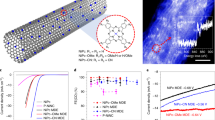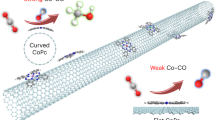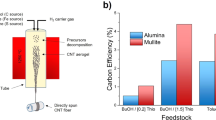Abstract
Carbon nanotubes (CNTs) have well-defined hollow interiors and exhibit unusual mechanical and thermal stability as well as electron conductivity1. This opens intriguing possibilities to introduce other matter into the cavities2,3,4,5, which may lead to nanocomposite materials with interesting properties or behaviour different from the bulk6,7,8. Here, we report a striking enhancement of the catalytic activity of Rh particles confined inside nanotubes for the conversion of CO and H2 to ethanol. The overall formation rate of ethanol (30.0 mol mol−1Rh h−1) inside the nanotubes exceeds that on the outside of the nanotubes by more than an order of magnitude, although the latter is much more accessible. Such an effect with synergetic confinement has not been observed before in catalysis involving CNTs. We believe that our discovery may be of a quite general nature and could apply to many other processes. It is anticipated that this will motivate theoretical and experimental studies to further the fundamental understanding of the host–guest interaction within carbon and other nanotube systems.
This is a preview of subscription content, access via your institution
Access options
Subscribe to this journal
Receive 12 print issues and online access
$259.00 per year
only $21.58 per issue
Buy this article
- Purchase on Springer Link
- Instant access to full article PDF
Prices may be subject to local taxes which are calculated during checkout




Similar content being viewed by others
References
Dai, H. Carbon nanotubes: Synthesis, integration, and properties. Acc. Chem. Res. 35, 1035–1044 (2002).
Ajayan, P. M. et al. Opening carbon nanotubes with oxygen and implications for filling. Nature 362, 522–525 (1993).
Seraphin, S., Zhou, D., Jiao, J., Withers, J. C. & Loutfy, R. Yttrium carbide in nanotubes. Nature 362, 503 (1993).
Tsang, S. C., Chen, Y. K., Harris, P. J. F. & Green, M. L. H. A simple chemical method of opening and filling carbon nanotubes. Nature 372, 159–162 (1994).
Guerret-Plécourt, C., Bouar, Y. L., Loiseau, A. & Pascard, H. Relation between metal electronic structure and morphology of metal compounds inside carbon nanotubes. Nature 372, 761–765 (1994).
Koga, K., Gao, G. T., Tanaka, H. & Zeng, X. C. Formation of ordered ice nanotubes inside carbon nanotubes. Nature 412, 802–805 (2001).
Sloan, J. et al. Metastable one-dimensional AgCl1−xIx solid-solution wurzite tunnel crystals formed within single-walled carbon nanotubes. J. Am. Chem. Soc. 124, 2116–2117 (2002).
Mühl, T. et al. Magnetic properties of aligned Fe-filled carbon nanotubes. J. Appl. Phys. 93, 7894–7896 (2003).
Farrell, A. E. et al. Ethanol can contribute to energy and environmental goals. Science 311, 506–508 (2006).
Deluca, T. H. Looking at biofuels and bioenergy. Science 312, 1743–1744 (2006).
Bhasin, M. M. & O’Connor, G. L. Procede de preparation selective de derives hydrocarbones oxygenes a deux atomes de carbone. Belgian Patent 824822 (1975).
Planeix, J. M. et al. Application of carbon nanotubes as supports in heterogeneous catalysis. J. Am. Chem. Soc. 116, 7935–7936 (1994).
Yoon, B. & Wai, C. M. Microemulsion-templated synthesis of carbon nanotube-supported Pd and Rh nanoparticles for catalytic applications. J. Am. Chem. Soc. 127, 17174–17175 (2005).
Girishkumar, G., Hall, T. D., Vinodgopal, K. & Kamat, P. V. Single wall carbon nanotube supports for portable direct methanol fuel cells. J. Phys. Chem. B 110, 107–114 (2006).
Zhang, A. M., Dong, J. L., Xu, Q. H., Rhee, H. K. & Li, X. L. Palladium cluster filled in inner of carbon nanotubes and their catalytic properties in liquid phase benzene hydrogenation. Catal. Today 93–95, 347–352 (2004).
Tessonnier, J., Pesant, L., Ehret, G., Ledoux, M. J. & Pham-Huu, C. Pd nanoparticles introduced inside multi-walled carbon nanotubes for selective hydrogenation of cinnamaldehyde into hydrocinnamaldehyde. Appl. Catal. A 288, 203–210 (2005).
Chen, W., Pan, X., Willinger, M., Su, D. & Bao, X. Facile autoreduction of iron oxide/carbon nanotube encapsulates. J. Am. Chem. Soc. 128, 3136–3137 (2006).
Chen, W., Pan, X. & Bao, X. Tuning of redox properties of iron and iron oxides via encapsulation within carbon nanotubes. J. Am. Chem. Soc. (2007, in the press, doi:10.1021/ja0713072).
Cao, F. et al. Reducing reaction of Fe3O4 in nanoscopic reactors of a-CNTs. J. Phys. Chem. B 111, 1724–1728 (2007).
Dujardin, E., Ebbesen, T. W., Hiura, H. & Tanigaki, K. Capillarity and wetting of carbon nanotubes. Science 265, 1850–1852 (1994).
Yin, H. et al. Influence of iron promoter on catalytic properties of Rh–Mn–Li/SiO2 for CO hydrogenation. Appl. Catal. A 243, 155 (2003).
Hanaoka, T. et al. Ethylene hydroformylation and carbon monoxide hydrogenation over modified and unmodified silica supported rhodium catalysts. Catal. Today 58, 271–280 (2000).
de Jong, K. P., Glezer, J. H. E., Kuipers, H. P. C. E., Knoester, A. & Emeis, C. A. Highly dispersed Rh/SiO2 and Rh/MnO/SiO2 catalysts: 1. Synthesis, characterization, and CO hydrogenation activity. J. Catal. 124, 520–529 (1990).
Trevino, H., Lei, G. & Sachtler, W. M. H. CO hydrogenation to higher oxygenates over promoted rhodium: Nature of the metal-promoter interaction in RhMn/NaY. J. Catal. 154, 245–252 (1995).
Ichikawa, M. & Fukushima, T. Infrared studies of metal additive effects on CO chemisorption modes on SiO2-supported Rh-Mn, -Ti, and–Fe catalysts. J. Phys. Chem. 89, 1564–1567 (1985).
Moigno, D., Callejas-Gaspar, B., Gil-Rubio, J., Werner, H. & Kiefer, W. The metal-carbon bond in vinylidene, carbonyl, isocyanide and ethylene complexes. J. Organometal. Chem. 661, 181–190 (2002).
von Ahsen, B. et al. Cationic carbonyl complexes of rhodium (I) and rhodium (III): Synthesis, vibrational spectra, NMR studies, and molecular structures of tetrakis(carbonyl) rhodium(I) heptachlorodialuminate and–gallate, [Rh(CO)4][Al2Cl7] and [Rh(CO)4][Ga2Cl7]. Inorg. Chem. 42, 3801–3814 (2003).
Kapteijn, F. et al. Alumina-supported manganese oxide catalysts: I. characterization: effect of precursor and loading. J. Catal. 150, 94 (1994).
Haddon, R. C. Chemistry of the fullerenes: The manifestation of strain in a class of continuous aromatic molecules. Science 261, 1545–1550 (1993).
Ugarte, D., Chatelain, A. & de Heer, W. A. Nanocapillarity and chemistry in carbon nanotubes. Science 274, 1897–1899 (1996).
Santiso, E. E. et al. Adsorption and catalysis: The effect of confinement on chemical reactions. Appl. Surf. Sci. 252, 766–777 (2005).
Dong, X., Zhang, H., Lin, G., Yuan, Y. & Tsai, K. R. Highly active CNT-promoted Cu–ZnO–Al2O3 catalyst for methanol synthesis from H2/CO/CO2 . Catal. Lett. 85, 237–246 (2003).
Acknowledgements
We thank Z. Tian and W. Weng from Xiamen University China for their help with Raman spectroscopy characterization and A. Goldbach for the discussion. We also acknowledge the financial support of the Natural Science Foundation of China and the Ministry of Science and Technology of China.
Author information
Authors and Affiliations
Corresponding author
Ethics declarations
Competing interests
The authors declare no competing financial interests.
Supplementary information
Supplementary Information
Supplementary information, figures S1-S6 and table S1 (PDF 4878 kb)
Rights and permissions
About this article
Cite this article
Pan, X., Fan, Z., Chen, W. et al. Enhanced ethanol production inside carbon-nanotube reactors containing catalytic particles. Nature Mater 6, 507–511 (2007). https://doi.org/10.1038/nmat1916
Received:
Accepted:
Published:
Issue Date:
DOI: https://doi.org/10.1038/nmat1916



